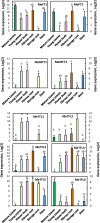Identification of FT family genes that respond to photoperiod, temperature and genotype in relation to flowering in cassava (Manihot esculenta, Crantz)
- PMID: 30543044
- PMCID: PMC6500508
- DOI: 10.1007/s00497-018-00354-5
Identification of FT family genes that respond to photoperiod, temperature and genotype in relation to flowering in cassava (Manihot esculenta, Crantz)
Abstract
Cassava is a starch-storing root crop that is an important source of dietary energy in tropical regions of the world. Genetic improvement of cassava by breeding is hindered by late flowering and sparse flower production in lines that are needed as parents. To advance understanding of regulatory mechanisms in cassava, this work sought to identify and characterize homologs of the FLOWERING LOCUS T (FT) gene. Ten members of the phosphatidylethanolamine-binding protein gene family, to which FT belongs, were obtained from the cassava genome database. Phylogenetic and sequence analysis of these proteins was used to identify two putative FT homologs which had amino acid sequences at key positions in accordance with those predicted for functional FTs. Expression of these ten genes was determined in mature leaves, immature leaves, flower buds, fibrous roots, storage roots and stem. The FT transcripts were expressed in mature leaves, as expected for their possible role in leaf-to-apical meristem signaling. In growth chamber studies, plants flowered earlier in long-day photoperiod than in short-day photoperiod. Expression studies indicated that while MeFT1 was expressed in leaves without a clear-cut photoperiod response, MeFT2 was expressed in a photoperiod-dependent manner, consistent with its involvement in photoperiodic control of flowering. In growth chambers that subjected plants to a range of temperatures from 22 to 34 °C, flowering was delayed by warmer temperatures although MeFT1 and MeFT2 expression declined in only one genotype, indicating other factors regulate this response. The earliest flowering genotype, IBA980002, had high levels of MeFT1 and MeFT2 expression, suggesting that both homologs contribute to earliness of this genotype.
Keywords: Cassava; FT; Flowering; Photoperiod; Phylogeny; Temperature.
Conflict of interest statement
The authors declare that they have no conflict of interest.
Figures





Similar articles
-
Correlation Between Relative Gene Expression Patterns of Two Flowering locus T (MeFT1 and MeFT2) in Cassava Leaf and Flowering Traits Under Different Flowering Induction Conditions.Pak J Biol Sci. 2022 Jan;25(5):369-379. doi: 10.3923/pjbs.2022.369.379. Pak J Biol Sci. 2022. PMID: 35638506
-
Overexpression of Arabidopsis FLOWERING LOCUS T (FT) gene improves floral development in cassava (Manihot esculenta, Crantz).PLoS One. 2017 Jul 28;12(7):e0181460. doi: 10.1371/journal.pone.0181460. eCollection 2017. PLoS One. 2017. PMID: 28753668 Free PMC article.
-
Photoperiodic and thermosensory pathways interact through CONSTANS to promote flowering at high temperature under short days.Plant J. 2016 Jun;86(5):426-40. doi: 10.1111/tpj.13183. Plant J. 2016. PMID: 27117775
-
Flowering time regulation: photoperiod- and temperature-sensing in leaves.Trends Plant Sci. 2013 Oct;18(10):575-83. doi: 10.1016/j.tplants.2013.05.003. Epub 2013 Jun 18. Trends Plant Sci. 2013. PMID: 23790253 Free PMC article. Review.
-
Cassava biology and physiology.Plant Mol Biol. 2004 Nov;56(4):481-501. doi: 10.1007/s11103-005-2270-7. Plant Mol Biol. 2004. PMID: 15669146 Review.
Cited by
-
Identification of Genomic Regions for Traits Associated with Flowering in Cassava (Manihot esculenta Crantz).Plants (Basel). 2024 Mar 12;13(6):796. doi: 10.3390/plants13060796. Plants (Basel). 2024. PMID: 38592820 Free PMC article.
-
Pathways to de novo domestication of crop wild relatives.Plant Physiol. 2022 Mar 28;188(4):1746-1756. doi: 10.1093/plphys/kiab554. Plant Physiol. 2022. PMID: 34850221 Free PMC article.
-
Flowering genes identification, network analysis, and database construction for 837 plants.Hortic Res. 2024 Jan 10;11(4):uhae013. doi: 10.1093/hr/uhae013. eCollection 2024 Apr. Hortic Res. 2024. PMID: 38585015 Free PMC article.
-
Flower-inducing technology facilitates speed breeding in cassava.Front Plant Sci. 2023 May 22;14:1172056. doi: 10.3389/fpls.2023.1172056. eCollection 2023. Front Plant Sci. 2023. PMID: 37284728 Free PMC article.
-
Bacillus velezensis strain B26 modulates the inflorescence and root architecture of Brachypodium distachyon via hormone homeostasis.Sci Rep. 2022 May 13;12(1):7951. doi: 10.1038/s41598-022-12026-6. Sci Rep. 2022. PMID: 35562386 Free PMC article.
References
-
- Adeyemo O, Kolmos E, Tohme J, Chavariaga P, Fregene M, Davis S. Identification and characterization of the cassava core-clock gene EARLY FLOWERING. Trop Plant Biol. 2011;4:117–125. doi: 10.1007/s12042-011-9065-6. - DOI
-
- Baumann K, Venail J, Berbel A, Domenech MJ, Money T, Conti L, Hanzawa Y, Madueno F, Bradley D. Changing the spatial pattern of TFL1 expression reveals its key role in the shoot meristem in controlling Arabidopsis flowering architecture. J Exp Bot. 2015;66:4769–4780. doi: 10.1093/jxb/erv247. - DOI - PMC - PubMed
-
- Bredeson JV, Lyons JB, Prochnik SE, Wu GA, Ha CM, Edsinger-Gonzales E, Grimwood J, Schmutz J, Rabbi IY, Egesi C, Nauluvula P, Lebot V, Ndunguru J, Mkamilo G, Bart RS, Setter TL, Gleadow RM, Kulakow P, Ferguson ME, Rounsley S, Rokhsar DS. Sequencing wild and cultivated cassava and related species reveals extensive interspecific hybridization and genetic diversity. Nat Biotechnol. 2016;34:562–570. doi: 10.1038/nbt.3535. - DOI - PubMed
Publication types
MeSH terms
Substances
Grants and funding
LinkOut - more resources
Full Text Sources

